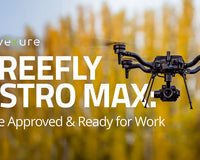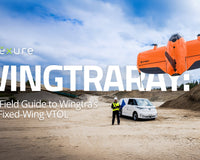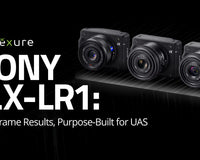Are you stuck between the DJI Matrice 300 RTK (M300) and the Matrice 30 (M30) series as your next drone? They're both powerful and reliable, but which one is best for your specific use-cases?
What are your team’s needs and pain points? Also, how can either of the two fit into your mission’s priorities? There’s a lot that goes into choosing the appropriate drone for your UAS team.
Knowing the specs of the different drones in the market, and how they compare to one another, is a solid step in the right direction.
So, the question is: is the newer M30 better, or do you need the tried-and-true M300? The answer: it depends on how you plan to use it.
Let's break it all down.
Matrice 300 Series Vs. Matrice 30 Series
There's a reason that DJI remains the leading drone manufacturer worldwide. The highly innovative company continuously releases drones that not only keep up with the market and customer demands, they exceed them. That goes for both enterprise and consumer-level UAS.
In March 2022, DJI released the M30 series, a foldable, portable system that changed the game for remote pilots. The same might be said for the M300 -- released in May 2020 -- which was the company's first true hybrid camera series drone, designed to accommodate several payload options.
So, what are the main differences between the two?
For starters, the M30 series consists of two different models: M30 and M30T, the latter of which includes a 40mm 640x512 30fps thermal imaging camera with measurement accuracy of ±2°C or ±2%.
With the M30, the payload you purchase is fixed. So, if you decide you need thermal imaging down the line, you'll need to upgrade your UAS completely to the M30T.
Related Article: Is the DJI Matrice 30 Series the Right Drone for You?
The DJI M300 RTK, on the other hand, has just one standard version. However, the payloads are interchangeable, which is great because DJI releases new iterations of powerful Zenmuse cameras with relative frequency. You also have various third-party options.
In fact, earlier this year, the company released Zenmuse H20N, which contains night vision ability, as a follow-up to the H20T. Essentially, when you need to upgrade, you don't need to invest in an entirely new UAS platform.
So, the M30 is portable and the M300 camera systems are interchangeable. Is that the only real difference? Not quite... let's talk about the features of each.
*Video comparison of H20N vs. H20T on a DJI M300 RTK performed by Advexure in May 2022
The Features
Is DJI M30 the most portable enterprise UAS? Not quite - that distinction belongs to the Mavic Enterprise Series. However, it may be the most versatile all-in-one solution.
The M300, on the other hand, is simply a powerhouse, and a versatile machine in its own right.
To know which one you need, you'll require some details. Let's start with the design.
Body design and size
The M30 is conveniently compact and lightweight, whereas the M300 is about twice its size. The former has a maximum take-off weight of about 8.16 lbs (3.7 kg), and the latter’s take-off weight is a beefy 19.8 lbs (9 kg).
Additionally, their dimensional footprint is vastly different:
- Unfolded M30- 18.5 × 23 × 8.5 inches
- Unfolded M300- 31.9 × 26.4 × 16.9 inches
- Folded M30- 14.5 × 8.5 × 7.5 inches
- Folded M300- 16.9 × 16.5 × 16.9 inches
If you want to pack up and go quickly, M30 might be the best option. But, if your job requires a drone with muscle, then M300 is the way to go.
So, how quickly does each get to the sky?
Consequently, each's size affects take-off time, leading us to the next point.

Deployability
As you might expect, the transition time from case to launch for M30 is way less than it is for M300. That's due to the M300 payload assembly and setup.
Essentially, unless you are adding an accessory such as the LP12 Spotlight and Speaker, M30 is ready to go right out of the box. The M300, on the other hand, requires you to choose a payload, and to attach the landing gear.
At Advexure, we've found that it takes right around two minutes to get the M300 RTK into the sky, while the M30 series takes, at most, a minute. While there's not a major difference in deployment times, in emergency situations, seconds matter.
Both drones do include a great battery feature, though, in that they're hot-swappable, which means you don't need to power down the aircraft to change out the batteries. More on that later in the article.
Now, let's get into flight time.
Flight time
"Under ideal circumstances, this drone stays in the sky for..."
Right, we all know that it never actually meets those times. But, it's a good place to start.
For the M300, you're promised to get up to 55 minutes of flight time with no payload attached. With H20T or H20N, we were getting about 28 minutes, while the GL60 Spotlight dropped the time down to 25 minutes. Of course, like most of you out there, we don't let the battery zero out to test the times...we'd let it get down to about 15 percent before landing.
Here are the estimated flight times provided by DJI:
| No Payload | 55 minutes |
| Zenmuse Z30 | 46 minutes |
| Zenmuse XT2 | 45 minutes |
| Zenmuse H20 | 43 minutes |
| Zenmuse Z30 + XT2 | 39 minutes |
| Zenmuse H20 + XT2 | 39 minutes |
| Max Payload (6 lbs) | 31 minutes |
As for the M30 series, DJI says you'll stay in flight for 41 minutes (36 minutes in hover). That's not too far off. We average between 28 and 35 minutes. However, with the addition of the LP12, that number does drop down by several minutes, just as it does with the spotlight for M300.
M300: Max 55 minutes
M30: Max 41 minutes

*DJI M30T with LP12 spotlight and speaker system during an evening mission
Camera systems and payload options
Alright, so we touched about these briefly...now we'll add some depth.
The M30 series gives you two options, as mentioned: Matrice 30 and Matrice 30T (thermal). Each camera system integrates a laser rangefinder payload that provides precise coordinates of objects up to 3,937 ft (1,200 meters) away, and includes a 48MP zoom camera 1/2'' CMOS sensor-zoom camera with 5×~16× optical and 200× digital zoom.
Additionally, with its 12MP wide-angle camera, you'll grab 8K photos and record videos in 4K 30FPS. There’s also an FPV camera that enhances the flight experience in low-light conditions.
The big difference between M30 and M30T is the M30T's thermal imaging camera - 40mm 640x512 30fps with measurement accuracy of ±2°C or ±2%. Again, if you need thermal imaging, you'll need to buy the drone itself as you can't upgrade later.
Conversely, the M300 can accommodate a variety of payload systems and accessories to cater to your different visual inspection needs.
The following payloads are compatible with DJI M300 RTK:
- Zenmuse H20N,
- Zenmuse L1,
- Zenmuse P1,
- Zenmuse H20/H20T,
- Zenmuse XT S,
- Zenmuse XT2,
- Zenmuse Z30,
- and third-party payloads developed based on the DJI Payload SDK.
A good example of a popular M300 payload is the H20T hybrid quad-sensor camera. The H20T payload includes a 12MP wide-angle camera with a 1/2.3” CMOS sensor, a 20MP 1/1/7" CMOS camera with 23x optical zoom and 300x max zoom capability, a laser rangefinder that tracks up to 3/4 mile, and a 640 x 512, 30Hz thermal imager.
Related Article- Which is Better: DJI Zenmuse H20N or H20T?
As for third-party payloads, you can find different thermal options (FLIR Vue TZ20), drop kits, and even gas detection systems.
If you want more options, longer flight time, and increased payload strength, you'll want to go with M300 RTK.
Battery system
Let's start with M30. It uses a pair of 5,8800 mAh LiPo TB30 Intelligent Flight Batteries for each flight.
Each battery supplies self-heating for cold environments, allows hot-swapping for fast turnarounds, and provides 400 charge cycles for increased operational efficiency. The TB30 can achieve up to 400 charge cycles within a 12-month period if it's charged to 90% or higher for fewer than 120 days combined.
The M30 series also uses the BS30 intelligent battery station, which stores eight TB30 intelligent flight batteries (each flight requires two) and one pair of WB37 RC Plus Controller batteries. It takes only about 30 minutes to charge the batteries up from 20 percent to 90 percent.
Additionally, it includes three charging modes:
Storage Mode: Each battery pair is charged to 50% in sequence and kept at 50% after charging.
Ready-to-Fly Mode: Each battery pair is charged to 90% in sequence and kept at 90% after charging.
Standard Mode: Each battery pair is charged to 100% in sequence.
Conversely, the M300 RTK operates with two 5,935 mAh LiPo 12S TB60 Intelligent Flight Batteries per flight.
The M300 RTK also uses the BS60 Intelligent Battery Station, which houses eight TB60 batteries and four WB37 batteries. It also allows you to charge two TB60 batteries and a WB37 battery simultaneously. The station includes two inputs -- 220V and 110V -- which permits you to charge your batteries at your own pace. The 110V fully charges two batteries in 70 minutes while the 220V takes about 60 minutes.
As mentioned previously, both the TB30 and TB60 batteries are hot-swappable, but the M30 has a new locking mechanism to safely detach one battery at a time without running the risk of powering off your UAV.
That locking system significantly reduces the risk of downtime during emergency operations.
IP rating
You've been there, right? You're all set up for a mission, or even in the sky, and rain starts to fall.
While most drones won't withstand much, if any, inclement weather, both the M300 and M30 are durable in terms of weather resistance.
M300 RTK is IP45 rated, which means that it can withstand a light to medium rainfall, and even smaller solid objects, such as screws and thin wires. Now, it's NOT fully weatherproof, so you'll still want to exercise caution.
The M30, on the other hand, is the most weather-resistant drone offered by DJI to date. With an IP55 rating, it's capable of withstanding heavier rain, and even some ice and snow.
M30 also has the optional DJI Dock with a built-in weather station - more on that in a bit.
Now, again, this rating isn't weatherproof, so you want to use your best judgement. However, both drones are ready for less-than-ideal weather conditions.
M300 RTK: IP45 Rated
M30 Series: IP55 Rated
Safety features
Each UAS comes prepared with quite a selection of top safety features, including:
- Multi-redundancy flight controls
- Health Management System
- An emergency three propeller control system.
- Backup systems
- DJI AirSense
- Obstacle collision sensing
However, the M300 takes safety a step further with a Primary Flight Display (PFD) and an Advanced Dual Control (ADC) mode. The PFD enhances situational awareness, whereas the ADC mode allows two remote controllers to connect simultaneously to a single drone.
Controller design
The M300 uses the DJI Smart Controller Enterprise, while the M30 uses the new DJI RC Plus. Both remote controllers use Pilot 2 software for a seamless navigation experience.
The M300 RTK Enterprise controller incorporates the following features:
- A 5.5-inch screen display.
- DJI OcuSync technology.
- It’s 4G compatible.
- Battery life of about 4 hours 30 minutes.
The RC Plus offers impressive features, too, such as:
- A 7-inch HD screen display.
- An IP54 rating.
- It has six additional manual control buttons on the side of the screen.
- A hot-swappable battery system.
- An ample 6-hour run time.
- It uses the O3 Enterprise OcuSync technology.
- Transmission redundancy backups include slots for your USB, SD, HDMI, and type C cable.
M300: DJI Smart Controller Enterprise
M30: DJI RC Plus
Autonomous capabilities
Both the M30 and M300 incorporate software, among other features, that enables autonomous operation.
For instance, the M30 is compatible with the ruggedly designed DJI Dock, which provides not only storage, but it also serves as an autonomous take-off and landing platform for your aircraft. Your M30 lands, charges, takes off, and executes missions programmed into DJI Flighthub 2, all from the DJI Dock.
The DJI Dock is built to operate 24/7, day or night. It's also weatherproof. Internal components have an IP67 rating, While the exterior is rated at IP55. DJI Dock requires minimal care and maintenance, and operates within a temperature range of -31°F to 122°F.
Matrice 300 RTK is not compatible with DJI Dock, but you can still set your mission flights through the DJI Pilot app, allowing you to make your workflow simpler and more efficient.
M300 and M30: Similarities
So, we've covered most everything about the UAS platforms. Now, let's look at the similarities between the two.
Flight speed
Maximum flight speeds for the two stand at 51 MPH, though, the M300 can only go up to 38 MPH in panoramic mode.
Wind-speed resistance
Both resist harsh, windy conditions at speeds of up to 34 MPH during a flight, and can land or ascend into the sky through winds of up to 27 MPH .
Transmission distance
Both have remote controller transmission ranges of about 5 miles.
Operating temperature
Since they are both weather resistant, they operate within the same temperature range of -4°F to 122°F.
FlightHub 2 compatibility
Both the M300 and the M30 are compatible with FlightHub 2 fleet management software. This software allows you and your team to remotely keep track of your flights, and to go back through flight data from various devices.
Therefore, the rest of your team or clients can receive real-time information from the ground as events of the drone operation unfold.
Obstacle avoidance
They have six unidirectional obstacle avoidance sensors, an essential safety feature when navigating congested flight areas.
Use Cases
Both of these UAVs have the potential to do exceptionally well in public safety operations, such as:
- City mapping
- Crime surveillance
- Search and rescue
- Firefighting
- Accident reconstruction
- Harbor and dock inspection
- Disaster relief
If you're not in public safety, both M30 and M300 provide plenty of benefit for land surveyors, construction, electrical, and telecommunication engineers to perform jobs such as:
- Photogrammetry
- Power line inspections
- Construction inspections
- Cell tower inspections
- Other routine maintenance operations.
Which is Better for You?
Undoubtedly, the M300 and M30 would both serve as great assets to any enterprise remote pilot. But, each has its advantages for different users.
Are you looking for an easy-to-operate your drone with minimal setup time and increased portability? The M30 would likely fit perfectly into your use-cases.
Conversely, if you like the idea of swapping payloads for different situations, and you want to the ability to upgrade without purchasing an entirely new drone, then you'll want to go with M300.
If you're still not sure which drone will work best for your operation, we're here to help.
At Advexure, our experienced team of UAS professionals not only use both platforms daily, but we also train teams like yours on how to use them properly in different scenarios. And, we get you set up with the best software and accessories so you're not lacking when it's time to fly.
To get started, connect with us or just open the chat box to speak with one of our drone experts. And, if you're in public safety, make sure to ask about our loaner and leasing program, where you can test the platform before buying.
Safe flying!










